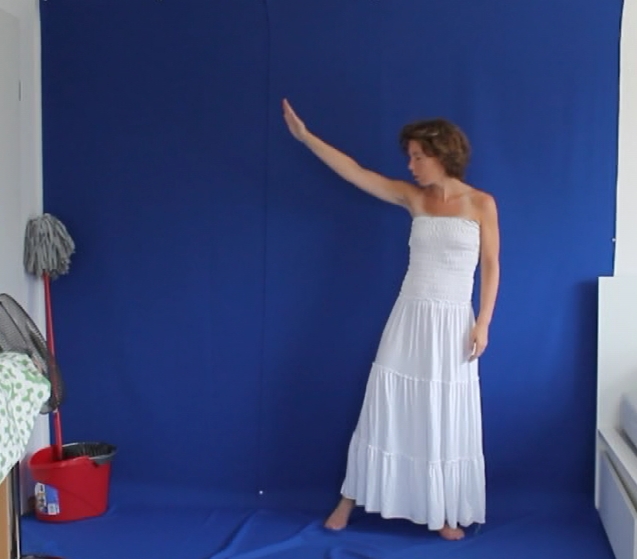 |
| Best source I could find for this image: IFLS. |
My first reaction was of course: It’s nonsense – a superficial play on the words “you” and “touch”. “You touch” whatever triggers the nerves in your skin. There, look, I’ve solved a thousand year’s old problem in a matter of 3 seconds.
Then it occurred to me that with this notion of “touch” my shoes never touch the ground. Maybe I’m not a genius after all. Let me get back to that cartoon then. Certainly deep thoughts went into it that I must unravel.
The average size of an atom is an Angstrom, 10-10 m. The typical interatomar distance in molecules is a nanometer, 10-9 meter, or let that be a few nanometers if you wish. At room temperature and normal atmospheric pressure, electrostatic repulsion prevents you from pushing atoms any closer together. So the 10-8 meter in the cartoon seem about correct.
But it’s not so simple...To begin with it isn’t just electrostatic repulsion that prevents atoms from getting close, it is more importantly the Pauli exclusion principle which forces the electrons and quarks that make up the atom to arrange in shells rather than to sit on top of each other.
If you could turn off the Pauli exclusion principle, all electrons from the higher shells would drop into the ground state, releasing energy. The same would happen with the quarks in the nucleus which arrange in similar levels. Since nuclear energy scales are higher than atomic scales by several orders of magnitude, the nuclear collapse causes the bulk of the emitted energy. How much is it?
The typical nuclear level splitting is some 100 keV, that is a few 10-14 Joule. Most of the Earth is made up of silicon, iron and oxygen, ie atomic numbers of the order of 15 or so on the average. This gives about 10-12 Joule per atom, that is 1011 Joule per mol, or 1kTon TNT per kg.
This back-of-the envelope gives pretty much exactly the maximal yield of a nuclear weapon. The difference is though that turning off the Pauli exclusion principle would convert every kg of Earthly matter into a nuclear bomb. Since our home planet has a relatively small gravitational pull, I guess it would just blast apart. I saw everybody die, again, see that’s how it happens. But I digress; let me get back to the question of touch.
So it’s not just electrostatics but also the Pauli exclusion principle that prevents you from falling through the cracks. Not only do the electrons in your shoes don’t want to touch the ground, the electrons in your shoes don’t want to touch the other electrons in your shoes either. Electrons, or fermions generally, just don’t like each other.
The 10-8 meter actually seem quite optimistic because surfaces are not perfectly even, they have a roughness to them, which means that the average distance between two solids is typically much larger than the interatomic spacing that one has in crystals. Moreover, the human body is not a solid and the skin normally covered by a thin layer of fluids. So you never touch anything just because you’re separated by a layer of grease from the world.
To be fair, grease isn’t why the Greeks were scratching their heads back then, but a guy called Zeno. Zeno’s most famous paradox divides a distance into halves indefinitely to then conclude then that because it consists of an infinite number of steps, the full distance can never be crossed. You cannot, thus, touch your nose, spoke Zeno, or ram an arrow into it respectively. The paradox resolved once it was established that infinite series can converge to finite values; the nose was in the business again, but Zeno would come back to haunt the thinkers of the day centuries later.
The issue reappeared with the advance of the mathematical field of topology in the 19th century. Back then, math, physics, and philosophy had not yet split apart, and the bright minds of the times, Descarte, Euler, Bolzano and the like, they wanted to know, using their new methods, what does it mean for any two objects to touch? And their objects were as abstract as it gets. Any object was supposed to occupy space and cover a topological set in that space. So far so good, but what kind of set?
In the space of the real numbers, sets can be open or closed or a combination thereof. Roughly speaking, if the boundary of the set is part of the set, the set is closed. If the boundary is missing the set is open. Zeno constructed an infinite series of steps that converges to a finite value and we meet these series again in topology. Iff the limiting value (of any such series) is part of the set, the set is closed. (It’s the same as the open and closed intervals you’ve been dealing with in school, just generalized to more dimensions.) The topologists then went on to reason that objects can either occupy open sets or closed sets, and at any point in space there can be only one object.
Sounds simple enough, but here’s the conundrum. If you have two open sets that do not overlap, they will always be separated by the boundary that isn’t part of either of them. And if you have two closed sets that touch, the boundary is part of both, meaning they also overlap. In neither case can the objects touch without overlapping. Now what? This puzzle was so important to them that Bolzano went on to suggest that objects may occupy sets that are partially open and partially closed. While technically possible, it’s hard to see why they would, in more than 1 spatial dimension, always arrange so as to make sure one’s object closed surface touches the other’s open patches.
More time went by and on the stage of science appeared the notion of fields that mediate interactions between things. Now objects could interact without touching, awesome. But if they don’t repel what happens when they get closer? Do or don’t they touch eventually? Or does interacting via a field means they touch already? Before anybody started worrying about this, science moved on and we learned that the field is quantized and the interaction really just mediated by the particles that make up the field. So how do we even phrase now the question whether two objects touch?
We can approach this by specifying that we mean with an “object” a bound state of many atoms. The short distance interaction of these objects will (at room temperature, normal atmospheric pressure, non-relativistically, etc) take place primarily by exchanging (virtual) photons. The photons do in no sensible way belong to any one of the objects, so it seems fair to say that the objects don’t touch. They don’t touch, in one sentence, because there is no four-fermion interaction in the standard model of particle physics.
Alas, tying touch to photon exchange in general doesn’t make much sense when we think about the way we normally use the word. It does for example not have any qualifier about the distance. A more sensible definition would make use of the probability of an interaction. Two objects touch (in some region) if their probability of interaction (in that region) is large, whether or not it was mediated by a messenger particle. This neatly solves the topologists’ problem because in quantum mechanics two objects can indeed overlap.
What one means with “large probability” of interaction is somewhat arbitrary of course, but quantum mechanics being as awkward as it is there’s always the possibility that your finger tunnels through your brain when you try to hit your nose, so we need a quantifier because nothing is ever absolutely certain. And then, after all, you can touch your nose! You already knew that, right?
But if you think this settles it, let me add...
.JPG) |
| Yes, no, maybe, wtf. |
And so, after having spent an hour staring at that cartoon in my facebook feed, I came to the conclusion that the question isn’t whether we can touch something, but what we mean with “some thing”. I think I had been looking for some thing else though…








